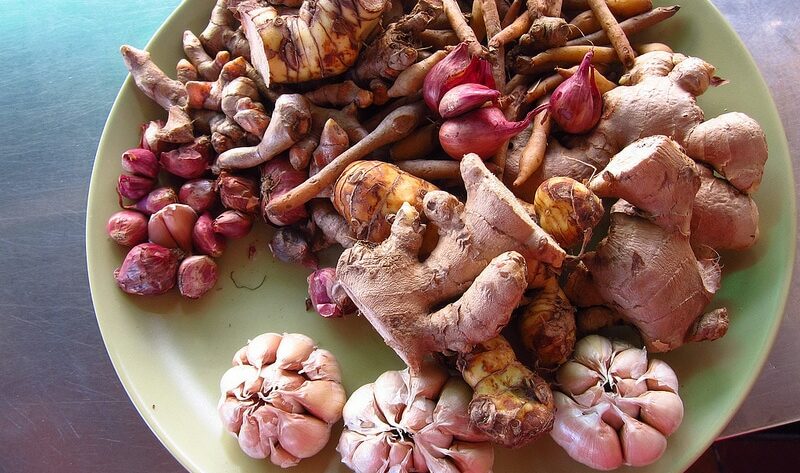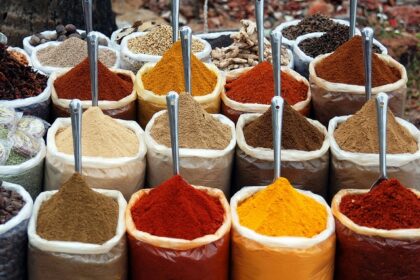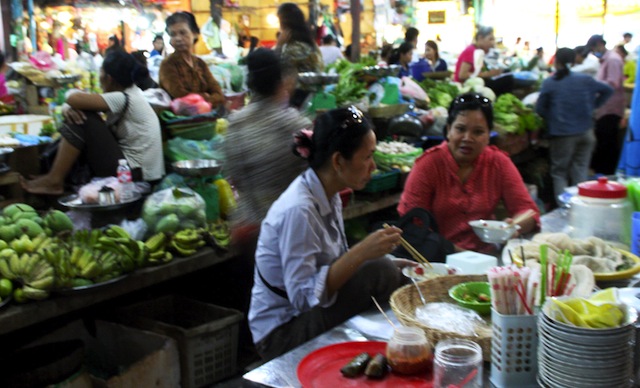
When in Cambodia, nothing beats the follow up to a full day of exploring the Angkor temples like an authentic Khmer meal and browsing the local markets. This must be a well-known fact in Siem Reap, because the town has plenty of both to offer.
Although the town has a population of less than 200,000 residents, the recent spike in tourism (due to the popularity of the Angkor Temples) has made Siem Reap a bustling city. With this, the main strip is lined with well-kept restaurants, markets and pubs on the aptly named Pub Street.
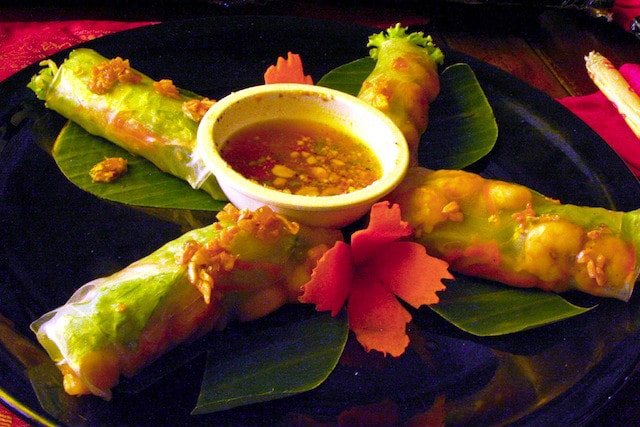
Ancient Recipes
I begin my exploration of culture in Cambodia with a night out on the town at Le Tigre De Papier, a French-Cambodian restaurant located on the corner of Pub and 2 Thnou Streets. It offers a wide selection of Cambodian cuisine, with a focus on ancient ingredients and cooking styles. This makes it unique to the region because it pre-dates the use of chili, which is a staple of South East Asian cuisine. It’s more subtle flavorings are instead influenced by cooking styles from China and France, as Cambodia is a former French colony. These cuisines are then infused with the rich array of fish from Cambodia’s Mekong River and Tonle Sap Lake.
After pouring over a seemingly endless mouth-watering menu, I decide on fresh spring roll appetizer, Khmer chicken bok choy as my main course and fried bananas for dessert.
Without the heavy use of chili and spices, freshness is key to creating great flavor in Cambodian cuisine. Le Tigre De Papier buys all of its products daily from the local market across the street to ensure all of their food is as fresh as possible. The effort is by far worth the while, as the spring rolls have a crisp taste, with the use of clear rice paper providing a nice contrast to the staple deep fried variation.

While chicken is not as popular as seafood in Cambodia, the coconut oyster dressing of my main course ties in flavors from the sea while working well to compliment the freshly steamed bok choy. The plate is also artistically displayed with folded banana leaves and bird-shaped carrots as garnish.
Although I am stuffed from the generous portion of chicken, it is impossible to say no to the dessert that follows. Brown sugar-fried bananas are accompanied by a selection of fresh mango and dragon fruit for a sweet, but (moderately) healthy end to the meal.
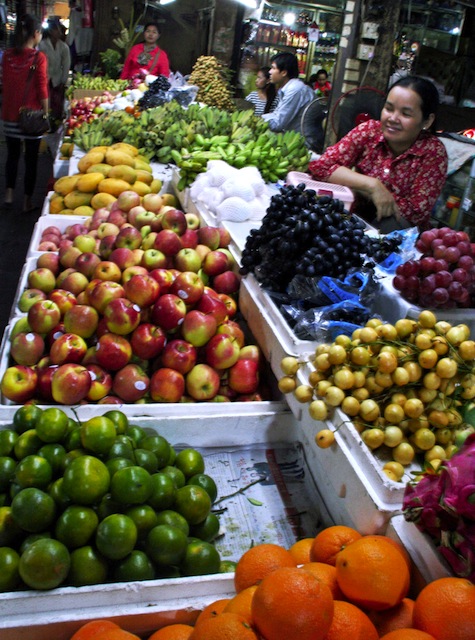
Local Market Treasures
Even after spending the day romping around the Angkor Temples, I feel like I need to get up off my feet again before I fall into a food coma, so I take off to explore the city. The chef at Le Tigre De Papier recommends I take a walk around the local market, which is conveniently right behind the restaurant. Since my meal was absolutely delicious, I am expecting a lot from this market and with that. Therefore, you can understand my initial surprise at being met with a dimly lit and fly covered entryway. Once my eyes adjust, however, brightly colored fruits, vegetables and flowers begin to pop out, followed by animated stall owners happily conversing with their patrons. Diners sit along long crowded tables, but are too enticed in their meals and conversation to really notice the equally large crowd of shoppers passing directly behind them. The whole area carries strong vibes of organized chaos and pride, as vendors loving prepare the finishing touches on their dishes and offer samples of their fruits to anyone looking even remotely interested.
Cambodia has recently overcome struggles with communism and the Khmer Rouge, followed by a collapsed economy and high levels of poverty. During this time, even the basic Cambodian culture and way of life was on the brink of vanishing, but the nation’s peoples worked relentlessly to preserve their values and are still reveling in the success of their endeavors.

As I turn a corner away from the edible section of the market, it immediately becomes apparent that all of this celebration cuts into time normally meant for organization, as I find myself face to face with a full 7-foot wall of shoes. That’s right, a full wall. Seemingly piled without the use of any type of shelving, several hundred pairs of sneakers, flats, sandals and high heels are piled on top of each other and around — and above, below and behind — a small cash register. I have recently worn through my favorite pair of sandals and am in the market for something new, so after taking a couple moments to digest the shear size of what lay ahead of me, I decide to dive, head first, into the large collection.
After spending some time rifling through dozens of pairs of shoes that seem to hold more glitter than an entire craft store, a pair of comparatively simple black Toms catches my eye. After trying them on, I unfortunately realize they aren’t even close to my size and begin to fruitlessly scour for another pair.
Noticing my search, a shop owner appears like magic from behind a particularly large pile of sandals and, after I explain my predicament, disappears as quickly as she had shown up. After a staggeringly short period of time, she — now wearing an enormous smile — is back, triumphantly holding an identical, but slightly larger pair of black Toms.
Although I can barely contain my excitement, I do my best to eye the shoes skeptically before trying them on. Haggling is expected at any market place in South East Asia, but your bargaining power as a buyer is greatly reduced if you show too much eagerness. Instead, I take a few steps in the shoes before removing them, telling the shopkeeper I might look around elsewhere as I eye a similarly massive wall of shoes just across the corridor.
Not wanting to lose the sale completely, I am then promised a good deal and ask how much I want to pay. I start with a low offer, knowing I will be haggled up regardless of what I set my starting point at, and after a few exchanges of potential prices, I walk away with a new pair of Toms for $7USD. While I’m fairly sure they’re not completely authentic, the shoes are comfortable and come with much more story and personality than any pair I would have bought from a mall.
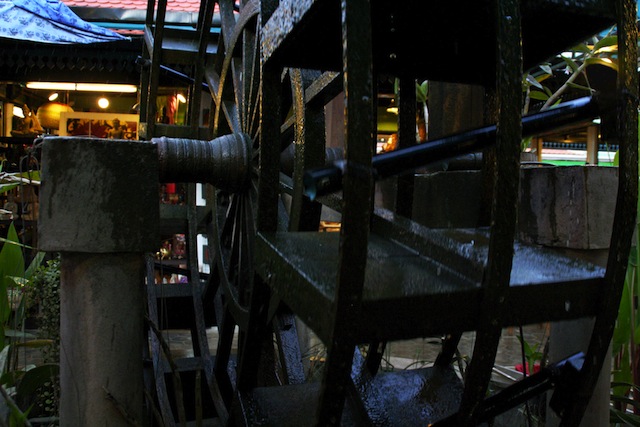
The Ambient Artist Market
With a new spring in my step, I am off to the final stop of the night, the Artist Market. Across the river from the main strip, the market is considerably cleaner and more spacious than the local market. Perhaps because virtually all of the stalls sell souvenirs targeted toward tourists used to higher standards of shopping. Personally, the seemingly over-the-top working waterwheel showcased in the middle of the market is my favorite accent of the space, as it adds a whimsical touch.
Instead of food and clothing, this market features gifts and souvenirs like Cambodia’s famous Kampot pepper, canvas prints of the iconic Angkor Temples and pashminas with Coach and Louis Vuitton logos that seem slightly stretched and off-centered. When I skeptically ask if a particular scarf is a real Louis Vuitton, I am given the answer “same-same but different”, a common phrase which basically means “it’s close enough.”

After perusing around, I exit the market only to be met with a colorful display of floating lights among the river way I had passed on my way in. The still waters below were as reflective as a mirror and it was easy to see how water brings so much life into the country.
I believe local businesses almost always showcase a region’s pride and personality, and with Cambodia’s long history, there’s definitely a lot to display.
About The Author
Currently working in a museum, Judi Zienchuk has lived everywhere from Southeast Asia to Northwestern Canada. She loves travel, longboarding and coffee flavoured ice cream. To get more personal, check out her blog, Travvel Sized.
Featured image of typical Cambodian root spices courtesy of fabulousfabs
Latest posts by Judi Zienchuk (see all)
- 5 Common Travel Practices That Are Detrimental For The Environment (And How You Can Easily Change Them) - Oct 7, 2017
- Gingerbread: History, Traditions And Where To See The World’s Sweetest Artwork - Dec 4, 2015
- The Dark Side Of Easter: Child Slave Labor And How To Source Ethical Chocolate This Holiday - Mar 16, 2015
- Tips For Giving Your Trip A Responsible Makeover - Mar 6, 2015
- Going Local In Sumatra, Indonesia - Oct 21, 2014

